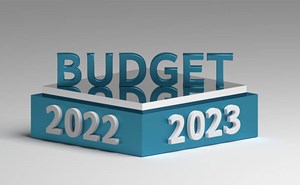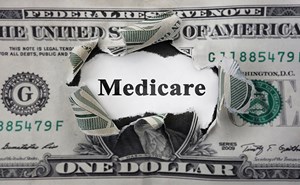Last week, President Biden released his Fiscal Year (FY) 2024 President’s Budget. As a reminder, every year, the White House releases a Budget that serves as its official funding request to Congress for the following fiscal year that begins in October. And that’s exactly what it is: a request. Congress can choose to accept some proposals, reject others, or simply use the Budget as a paper weight (which is the most likely option in this Congress… )
The Budget includes both funding requests for specific federal agencies that would be handled through Congress’ appropriations process as well legislative proposals for Congress’ authorizing Committees to consider. These legislative proposals in the health care space usually involve structural reforms to the Medicare and Medicaid programs and/or private insurance market that would add new or refine benefits; cut costs; or address fraud, waste, or abuse.
While the Budget has no chance of being adopted in full, I would argue that its still an extremely useful exercise for the Administration to go through each year. The Budget is a set opportunity for the Administration to lay its cards out on the table and show Congress and the public what it really cares about and what it doesn’t; what it’s willing to invest in and what it’s willing to cut.
Like last year’s Budget, the FY 2024 Budget includes some significant, cross-cutting priorities that are extremely important topics on which to focus. While I’m not going to discuss all the health care-related policies, proposals, and funding requests included in the Budget, I do want to focus on a few priorities.
Medicare: The insolvency of the Medicare Part A Trust Fund (i.e., when the Trust Fund is expected to go “bankrupt”) has been a perennial issue. The latest Medicare Trustees Report estimates that the Part A Trust Fund will be depleted by 2028. The Budget proposes to extend the solvency of the Medicare trust fund by at least 25 years by raising the Medicare tax for high-income individuals. While this tax increase has no chance of passing Congress, by including it in the Budget, the Administration is putting pressure on legislators to figure out how to ensure that Medicare is financially viable going forward.
The Budget also includes a number of other Medicare-related proposals around making prescription drugs more affordable, increasing access to mental health services (including a proposal to require Medicare to cover three behavioral health visits without cost-sharing), holding long-term care facilities more accountable, creating a permanent Medicare Diabetes Prevention Program benefit, and renewing funding for quality measure development. There are other smaller proposed policies as well—but what’s missing: PHYSICIAN PAYMENT REFORM! Unfortunately, there is no proposal in the Budget to add stability to Medicare physician payments, despite the fact that payments have failed to keep pace with inflation for decades. Also missing are any reforms to rein in Medicare Advantage private health plan spending. Despite the fact that the U.S. Department of Health and Human Services (HHS) Budget in Brief itself notes that “payments to plans are 106 percent of what they would be to provide Part A and B benefits in fee-for-service, negatively affecting Part A solvency and increasing Part B premiums for beneficiaries,” the Budget offers no solution to address this issue! Finally, the Budget does not include any proposed reforms to the Merit-based Incentive Payment System (MIPS)—the main quality program for physicians under Medicare. We were hoping that the Budget would request additional funding to continue the $500 million exceptional bonus pool, but unfortunately that proposal didn’t make the cut.
Medicaid and Private Insurance Reforms: The Budget acknowledges that many individuals who have been enrolled in Medicaid throughout the COVID-19 public health emergency (PHE) will likely no longer be eligible and will lose their coverage. To address this issue, the Budget includes a few major, costly proposals that will help those individuals who lose their Medicaid coverage afford private health insurance through the Affordable Care Act (ACA) Exchanges. First, the Budget proposes to permanently expand premium tax credit eligibility by eliminating the required contribution for individuals and families making 100 percent to 150 percent of the poverty level and limiting the maximum income contributions towards benchmark plans to 8.5 percent of income. Additionally, this proposal removes the 400 percent of the poverty level ($120,000 for a family of four) cap on premium tax credit eligibility. Second, the Budget addresses the coverage gap for individuals in states that have not expanded Medicaid (those who makes less than 100 percent of the poverty level but too much to qualify for Medicaid) by providing “Medicaid-like coverage…paired with financial incentives to ensure States maintain their existing expansions.” The Budget is, however, devoid of detail of what this Medicaid-like coverage would entail but estimates that it will cost the government $200 billion over ten years.
Interestingly, the Budget also includes two proposals related to the No Surprises Act. Perhaps acknowledging that the implementation of the Act has been far from seamless, the Budget requests $500 million in administrative funding over ten years to help with the “enforcement of plan, issuer, and provider compliance; complaints collection and investigation; as well as auditing comparative analyses of non-quantitative treatment limits for mental health and substance-use disorder plan benefits.” In addition, the Budget proposes to extend the surprise billing protections to ground ambulances—which were not included in the No Surprises Act.
Lastly, I would like to note a small, but important proposal related to Medicaid managed care plans. I have previously written about the bad payor behavior exhibited by these plans, including the routine downcoding and denial of emergency department (ED) evaluation and management (E/M) services—and the lack of oversight of these plans. The Budget states that “CMS has inadequate financial oversight and compliance tools in Medicaid managed care” and therefore proposes revisions to “enhance CMS’s ability to take meaningful actions to protect beneficiaries and enforce requirements.” This is a welcome proposal and hopefully the Centers for Medicare & Medicaid Services (CMS) will follow through.
Behavioral Health: Like last year, the Budget makes mental health a significant priority and proposes investments in the behavioral health workforce, youth mental health treatment, Certified Community Based Behavioral Health Clinics, Community Mental Health Centers, and mental health research. The Budget also strengthens access to crisis services by investing $836 million in the 9-8-8 and Behavioral Health Services program, an increase of $334 million over FY 2023 levels. This investment will increase capacity for 988 to respond to 100 percent of the estimated 9 million contacts in 2024. The Budget also invests $100 million for mobile crisis response, $80 million over FY 2023 levels, to help expand partnerships with 9-8-8 local crisis centers, community providers, 9-1-1 centers, and first responders.
The Administration also sees the benefit of community harm reduction services and proposes to provide $50 million for a national harm reduction program. Reaching approximately 330,000 individuals, the program would support distribution of naloxone, prevent overdose deaths, increase testing for HIV and viral hepatitis, and provide peer support services. The Budget also proposes to increase access to naloxone by providing $78 million to the First Responder Training program, an increase of $22 million over FY 2023 levels, and providing $28 million for grants to prevent overdose, an increase of $12 million.
Furthermore, the Budget continues to support the grant programs authorized by the Dr. Lorna Breen Health Care Provider Protection Act that help the health care workforce respond to workplace stressors, better endure hardships, reduce burnout, and foster healthy workplace environments that promote mental health. Specifically, the Budget requests $25 million to fund 23 awards to support health care organizations (such as hospitals, community health centers, and rural health clinics, or medical professional associations) to adopt, promote, implement, and demonstrate an organizational culture of wellness and mental health for their health professional wellness.
Workforce Shortages: As you all know too well, workforce shortages exist across the health care sector. The Budget attempts to address healthcare workforce shortages through new investments, including $32 million to increase the nurse faculty essential to growing the nation’s nurse workforce, and $28 million in innovative approaches to recruit, support, and train new clinicians. With respect to this “innovation funding,” the Health Resources and Services Administration (HRSA) plans to award 13 new grants to seed new approaches and strategies to grow the health care workforce. It is unclear whether any of this funding will be dedicated to helping to address the staffing shortages that are contributing to ED boarding. ACEP is meeting with the White House on Friday to discuss this extremely important topic.
Preparedness: The Administration has made a concerted effort to beef up its approach to pandemic prevention and disaster preparedness. Last year, the office responsible for managing disasters was transformed into its own separate agency within HHS, the Administration for Strategic Preparedness and Response (ASPR). Going from an office to an agency is a significant step, as agencies can receive their own separate appropriation from Congress and have more authority and autonomy. To that end, the Budget requests $400 million in new discretionary resources for ASPR to prepare for pandemics and biological threats.
The Budget separately requests around $2 billion for both the Biomedical Advanced Research and Development Authority (BARDA) and the Strategic National Stockpile (SNS) to support advanced development and procurement of vaccines, therapeutics, and diagnostic capabilities against known and unknown high priority threats. This represents a significant increase from current funding levels.
In addition, the Budget includes a total of $10.5 billion to “build public health capacity at the CDC and at the State and local levels, including expanding capacity to respond to emerging threats, including surveillance, laboratory, and public health workforce capacities.” Furthermore, the Budget includes $50 million for the Public Health Emergency Fund to ensure HHS is able to respond to emerging public health threats without delay.
Rural Health: As rural hospitals continue to close (according to HRSA, there have been 143 rural hospital closures from 2010 through January 2023, peaking with a high of 19 in 2020 just as the pandemic hit), the Budget includes significant investments to improve the health of rural communities, including by helping rural hospitals stay open, expanding the pipeline of rural healthcare workers, and facilitating access to quality care. The Budget includes $10 million to provide emergency targeted, in-depth high quality technical assistance to rural hospitals within rural communities severely at-risk for imminent closure and struggling to maintain health care services. In addition, the Budget requests another $20 million to fund a new “Rural Hospital Stabilization Pilot Program,” which will provide support to at-risk rural hospitals to enhance and or expand service lines to retain health care services locally and increase service volume and revenue that will enhance hospitals’ financial viability. Recognizing that rural communities have higher rates of suicide, and high rates of overdose deaths and mental illness, the Budget provides $10 million in new grant funding to support 12 rural health clinics (RHCs) to expand their behavioral health care service lines and add behavioral health providers.
Veterans’ Health Care: The Budget requests a significant increase in funding ($2.3 billion above the 2023 levels) to fully fund inpatient, outpatient, mental health, and long-term care services and enhance the health care quality and delivery. The Budget also invests $139 million within VA research programs to increase access to quality mental health care and lower the cost of mental health services for veterans. In addition, the Budget provides $559 million to further advance the Administration’s veteran suicide prevention initiatives, including continued expansion of the Veterans Crisis Line’s 988.
These are only some of the many, many proposed policies and requests included in the Budget. If you have any questions about these, or if you read about some other funding request and want to learn more about that, please let me know!
The ball is now in Congress’ court. It remains to be seen whether Congress will work on any of the priority areas in the Budget and eventually fulfill any of the funding requests or adopt any of the legislative proposals. FY 2024 doesn’t begin until October 1, 2023, and, knowing Congress’ tendency to act at the last moment, we probably won’t find out for a while.
Until next week, this is Jeffrey saying, enjoy reading your regs with your eggs!






